TABLE OF CONTENTS
Apple’s ARM-based MacBooks are, without a shadow of a doubt, amongst the best laptops on the market.

That doesn’t necessarily mean they’re the best option for everyone, but the sentiment nonetheless holds true. Their build quality, performance, and overall efficiency are unmatched.
To put it a bit more bluntly: there’s not a laptop out there that can stand on even ground and match all the many features and creature comforts which Apple’s MacBooks bring to the table.
And we, for one, couldn’t be happier for that being the case; it sure took a while for Apple to reach this point.
Its (somewhat recent) past is laden with horrendous design choices, awful Intel processors which throttled beyond measure, butterfly keyboards, and a host of other debacles, most of which — amongst the enthusiasts, at least — gave this company a bad rap.
This is, after all, the company which thought that creating a near portless 12” MacBook made sense.
Now, though, with this shift to a wholly different architecture, one simply has to give Apple credit — this Cuppertino-based tech giant has managed to correct course in a way which commands awe.
The oft-lambasted “Apple tax” has fallen to the wayside as well. The M1 MacBook Air, for instance — despite its mind-blowing performance — can be bought brand new for as little as $799.
The 14” and 16” MacBook Pros which are designed for the most demanding creatives out there are also reasonably priced.
And just writing such a thing makes one feel strange as if we’ve all been transported to a different timeline; we are, after all, talking about a company that sells $19 polishing cloths and $699 Mac Pro wheels.
With all of that being said, there are a few wholly unique drawbacks and limitations that warrant a deeper dive, and they’re all tied to the aforementioned ARM architecture which Apple chose to employ.
We already covered that topic in great detail, so we’ll just mention the essentials down below.
Apple MacBooks — One Big Drawback
The only true drawback of Apple’s M1- and M2-based MacBooks is, well, their very architecture. It brings many wholly unique benefits, but also a few very peculiar quirks you need to be aware of — and they’re all tied to software compatibility.
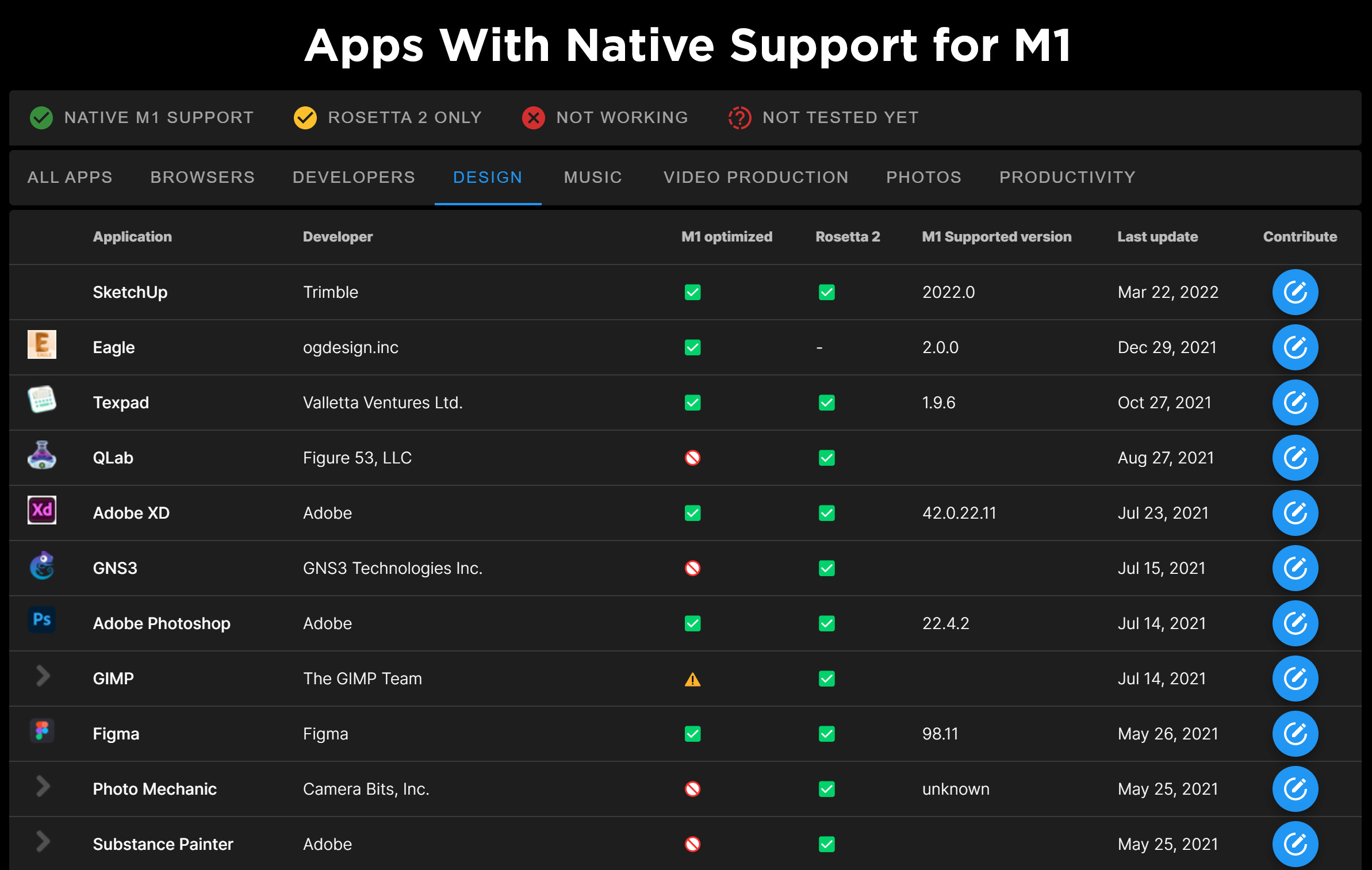
Image Source: isapplesiliconready
These chipsets can still emulate x86 programs through the oft-talked about Rosetta 2 emulation layer but, depending on the application, you might not encounter praiseworthy performance. It all varies, frankly. Some work great, whereas others take an eternity in order to open up and initialize.
Fortunately, everyone seems to have boarded the ARM-based hype train — hence the tremendous adoption rate. This issue, therefore, isn’t nearly as precarious and unassailable as it seemed back when these laptops first started shipping.
To make things even better, some of today’s most popular programs not only run natively on Apple’s M1 and M2 chipsets but, more often than not, run a lot better than they do on Windows.
And so, with that in mind, you really need to think twice in regards to which programs and software suites you need most before making any kind of purchasing decision. Native applications work flawlessly and, frankly, are so fast and snappy that it doesn’t even make sense.
Those that have to be emulated, however, are a bit of a mixed bag.
Your mileage will vary. If your main programs are supported, you’ll have a truly spectacular user experience — that much is basically guaranteed.
Apple MacBook Portfolio — Full Breakdown
Apple, unlike most other OEMs, only has two separate lines of laptops: the Air and the Pro. There’s nothing more, and nothing less. This, in short, removes any potential confusion and, by proxy, simplifies and streamlines the entire buying experience.
It is, in other words, an ingenious approach.
Both of these lines share the same “DNA” as well, so you only need to ask yourself the following question: what kind of work will I be doing?
Another great thing with Apple laptops — and, frankly, it’s a pretty unique trait — is the fact that they’re all built exactly the same (which is to say: spectacularly) and have many of the same features.
The best and most expensive models obviously stand out with their plentiful additions, but the point stands nonetheless.
Most other OEMs only have one or two premium lines to offer and, the lower the product stack you go, the worse things get. Dreadful build quality, awful, dim displays, iffy keyboards, rattly trackpads, squeaking hinges, and so on and so forth.
Apple, however, does things differently: it offers the same “base” as all of its laptops, and that includes a beautiful, color-accurate, 16:10 display that’s plenty bright, one of the best keyboards out there, a spacious trackpad (industry-leading, in fact), and a kind of build quality and attention to detail seldom seen.
And so, with that little “introduction” out of the way, let’s take a closer look at Apple’s entire laptop portfolio:
MacBook Air [M1] — One of the Best Laptops Out There
The MacBook Air is, without a shadow of a doubt, one of the best and most popular ultrabooks out there. And, well, with good reason.
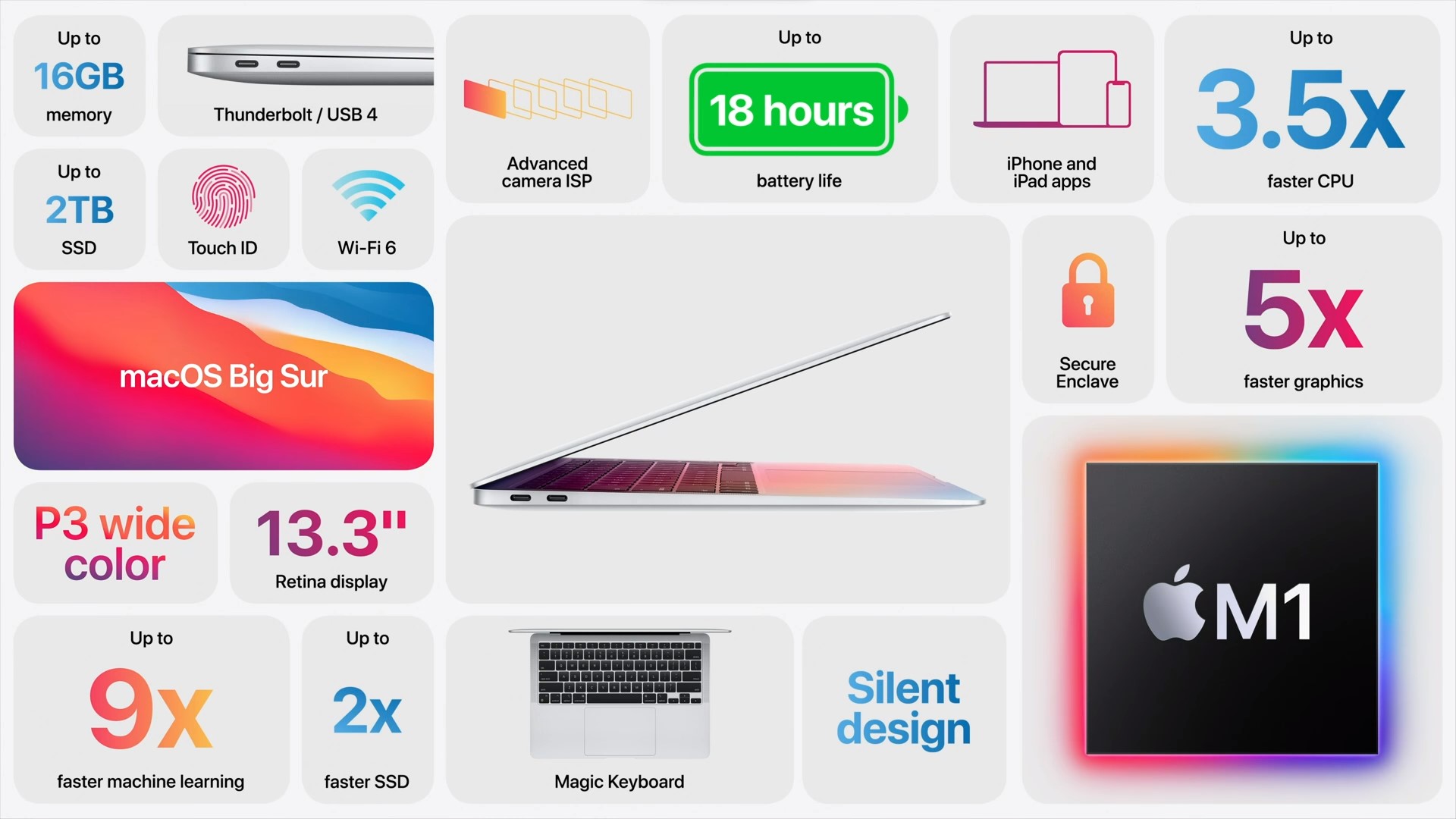
Image Credit: Apple
It has always been a stellar option for those who were in the market for a top-notch ultrabook, but it was also tremendously flawed for a good three years (2018-2020); its keyboard was prone to malfunctioning, it had thermal throttling issues, shoddy performance, and so on and so forth.
Now, though, with Apple fully transitioning to its own silicon, these performance-related issues are finally a thing of the past.
And, after years of clamoring and pleading, Apple also decided to revert its butterfly keyboards to a more standard, chiclet-style setup with appropriate key travel.
Moreover, the performance uplift which Apple’s M1 and M2 — to say nothing of the Pro and Max variants — brought to the table was nothing short of a quantum leap.
MacBooks now lead the pack in overall power efficiency, battery life, and performance when unplugged.
Better yet, their peak performance is very much comparable to that of Intel and AMD’s best offerings, which means that — as far as sheer horsepower is concerned — there’s literally nothing to complain about.
In other words: ample horsepower without the heat and noise.
All of this might sound like marketing hogwash but, in reality, it is anything but. Apple was just the first company to harness the full potential of ARM — it really is that simple.
And it had to be Apple, too, as it has the kind of funding and RND money to truly embark on such a tremendously challenging journey (and come out “unscathed”).
The MacBook Air M1, despite its slim profile, is actually a powerhouse. Laptops that cost twice as much still can’t compete on even footing, despite being thicker, heavier, and packed with more power-hungry internals.
And so, in a way, it’s the perfect “package.” Mind-blowing performance, incredible battery life (you can easily get ten-plus hours of use), a stellar keyboard, a beautiful display, and a kind of build quality that is unmatched.
It’s worth its weight in gold.
MacBook Air [M2] — Better But Also Worse
The M2 MacBook Air really is a sight to behold, but it’s also — depending on the SKU — a worse laptop when compared to its predecessor. The M2 is more powerful, but marginally so.
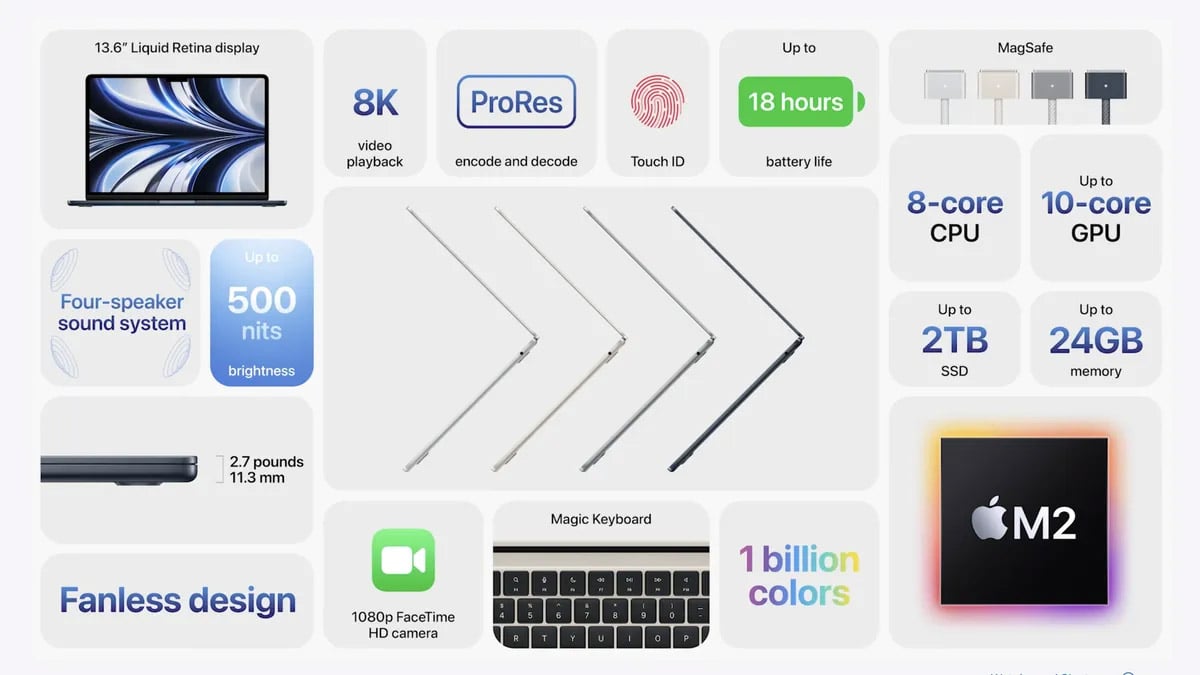
Image Credit: Apple
What will make a difference, however, is the fact that Apple chose to use just a single NAND chip for storage (on the 256GB SKUs) as opposed to two, effectively halving its performance (or speed, rather).
The thing is, if you’re a “casual” user, you’re not going to notice the difference during your day-to-day usage.
The base M2 MacBook Air is still a spectacular device (and a devilishly fast one, too), but if you start pushing it, it will perform a fair bit worse than the M1 Air.
The base M2 MacBook Pro has the same issue, and so does the 256GB M2 Mac Mini. To learn more about it, make sure to watch the following video:
This can, to be fair, be circumvented by opting for the 512GB model, but paying an additional $200 only for your laptop to perform as well as its direct forerunner sounds a bit ludicrous. Then again, it is within Apple’s M.O.
Other than that, the M2 MacBook Air, when compared to its predecessor, comes with the beloved MagSafe charging port, is still passively cooled, has a slightly brighter (and larger) display, thinner bezels, and a redesigned chassis.
Do these improvements justify a higher MSRP? That’s a question only you (and your wallet) can answer, but those upgrades sure are alluring.
To experience the M2 MacBook Air at its best, you’ll have to shell out an additional $400 for the upgraded RAM and storage and, at that point, you might as well buy a 14” MacBook Pro as it’s tremendously more powerful (and, therefore, actually worth the asking price).
MacBook Pro 13” [M1/M2] — A Strange Top-tier Laptop
The 13” MacBook Pro no longer has a place within Apple’s line-up. It’s a spectacular option, there’s no doubt about it, but it doesn’t really bring that big of an improvement over the regular MacBook Air.
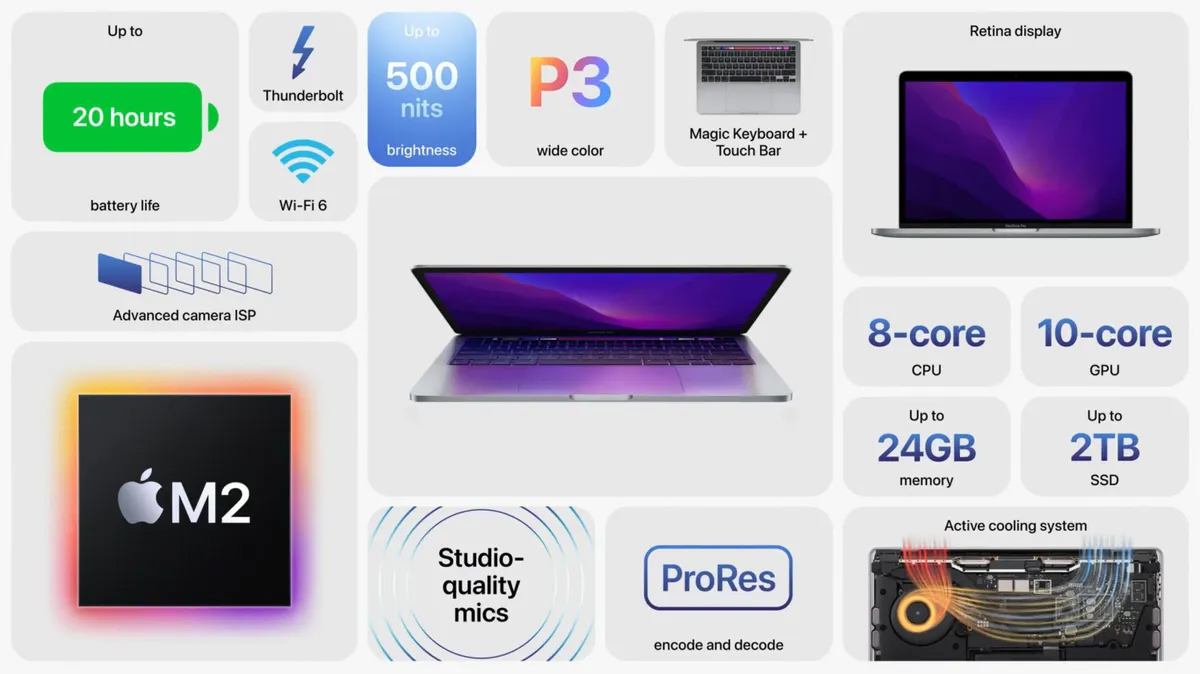
Image Credit: Apple
The M1 and M2 chipsets perform about the same in both machines; you’ll only be able to notice a bit of thermal throttling and slower export/render times with the passively cooled Air.
The Pro, thanks to it having a fan, can sustain its performance over longer periods of time, but that delta we’re talking about is nowhere near as tremendous as Apple would want you to believe.
It does have a brighter screen but, to be fair, the 400 nits of maximum brightness on the Air is more than sufficient. You also get the oft-talked-about Touch Bar instead of a (objectively more practical) function row — some people love it, others can’t stand its existence.
And so, for a higher MSRP, you get slightly better performance in a select few workloads. That’s… not really worth the uptick in price, and it really goes to show just how stellar a device the MacBook Air really is.
The performance delta between them is (relatively) minute, whereas the price difference is not.
The MacBook Pro is also thicker, and heavier, and comes with the exact same I/O as the (M1) MacBook Air which only further complicates things.
It’s a hard laptop to recommend solely due to the existence of the MacBook Air which, for less money, offers nearly identical performance. In other words: it hasn’t really earned the “Pro” moniker.
MacBook Pro 14”/16” [M1/M2 Pro/Max] — Without Equal
These laptops are the very best that Apple has to offer and, frankly, are amongst the most well-rounded and capable laptops money can buy.
They’re spectacular, is what they are, and there’s a very good reason why so many tech journalists and influencers — despite being “Windows heads” — opted to switch the moment they came out.
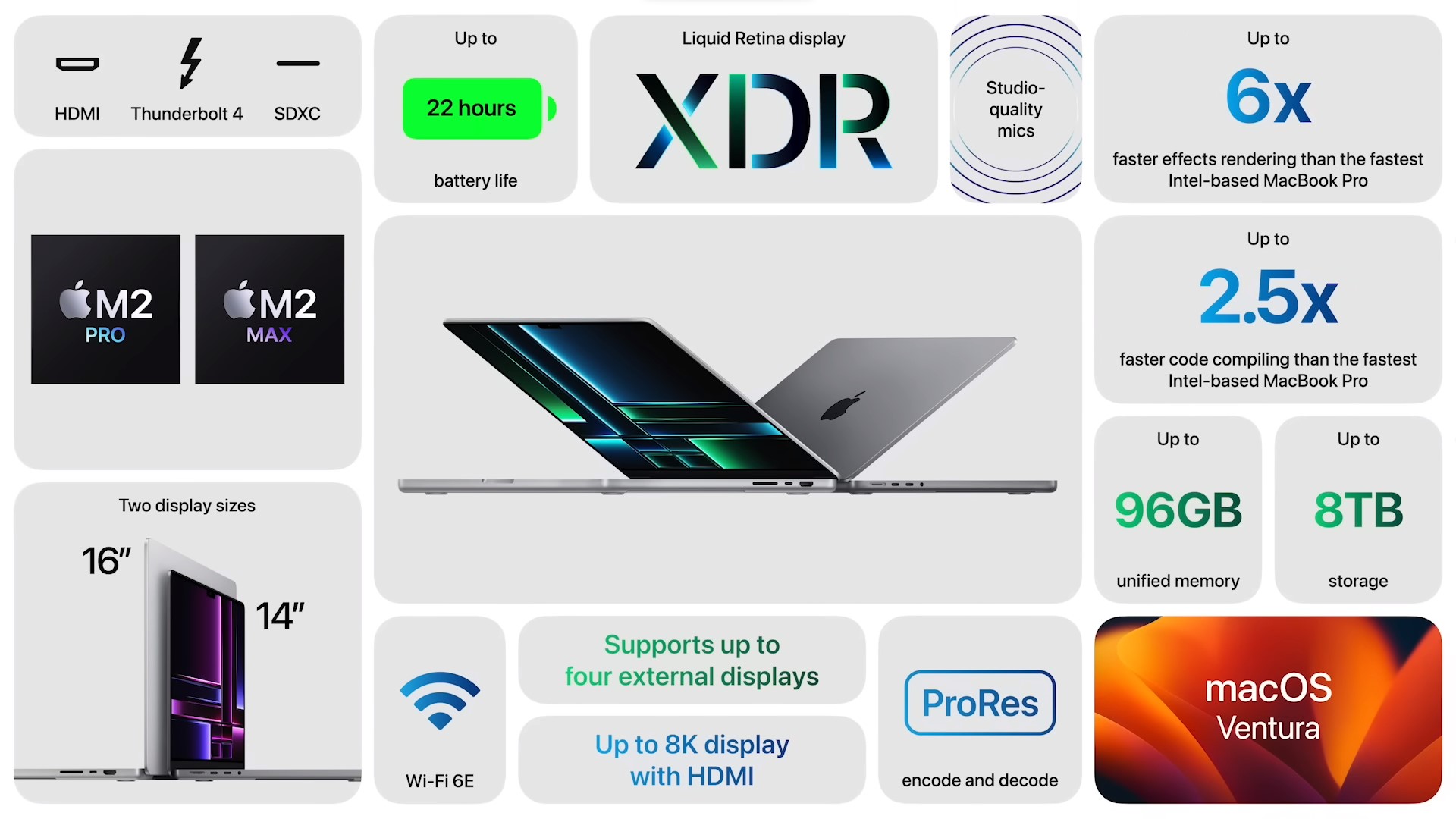
Image Credit: Apple
They’re perfect in every which way. They’re silent, stupendously capable, and yet mighty efficient, too. A stellar mix, all things considered — and an incredibly rare one, at that.
Everything that needed to be upgraded was. These machines come with jaw-dropping, variable refresh rate Mini-LED displays, more potent chipsets, higher RAM capacities, and — a rarity for Apple — a stellar selection of ports, too.
On the left-hand side, there’s a MagSafe charger, two USB-C ports (Thunderbolt 4), and a headphone jack. On the right, there’s a full-size SD card reader, another USB-C port (also Thunderbolt 4), and even a full-size HDMI port — 2.0 on the 2021 models and 2.1 on the last generation.
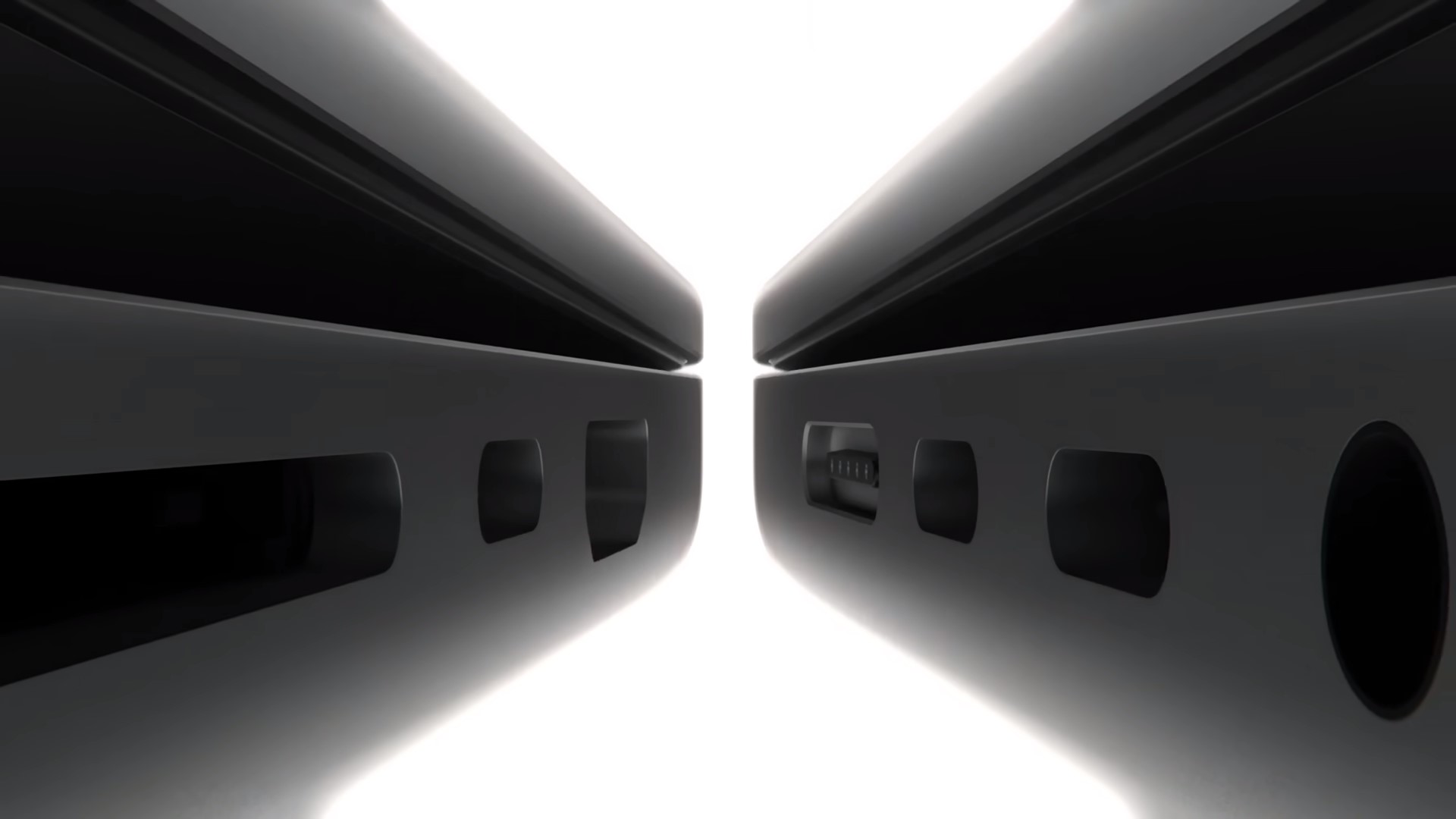
Image Credit: Apple
There’s really nothing to complain about. If you’re a creative professional — or want to become one — there’s no better option out there.
Don’t over-spec it, though. Just because there’s a more powerful SKU available doesn’t mean it’ll give you a palpable uptick in performance, as evidenced in the following video:
MacBook Air vs. MacBook Pro 13” — Which Is Better?
The Air wins out handily. There’s just not that big of a difference between them and yet the Air is lighter, thinner, has a dedicated function row, is always completely silent (due to it being passively cooled), and is a fair bit cheaper as well.
The Pro has slightly better battery life but, in all fairness, you’re never going to “run out of juice” at an inopportune moment even with the MacBook Air.
And even though the 13” Pro can sustain its performance for longer, there isn’t that big of a benefit as the Air will still get the job (i.e. render or export) done without any issues.
If shaving off ten seconds (or a few minutes, depending on the project) is worth upgrading then, by all means, go with the Pro. If not, the Air is definitely the better choice.
Should You Buy a MacBook With the M1 or M2?
The M2 is the superior chipset, but it’s not that much better than the M1.
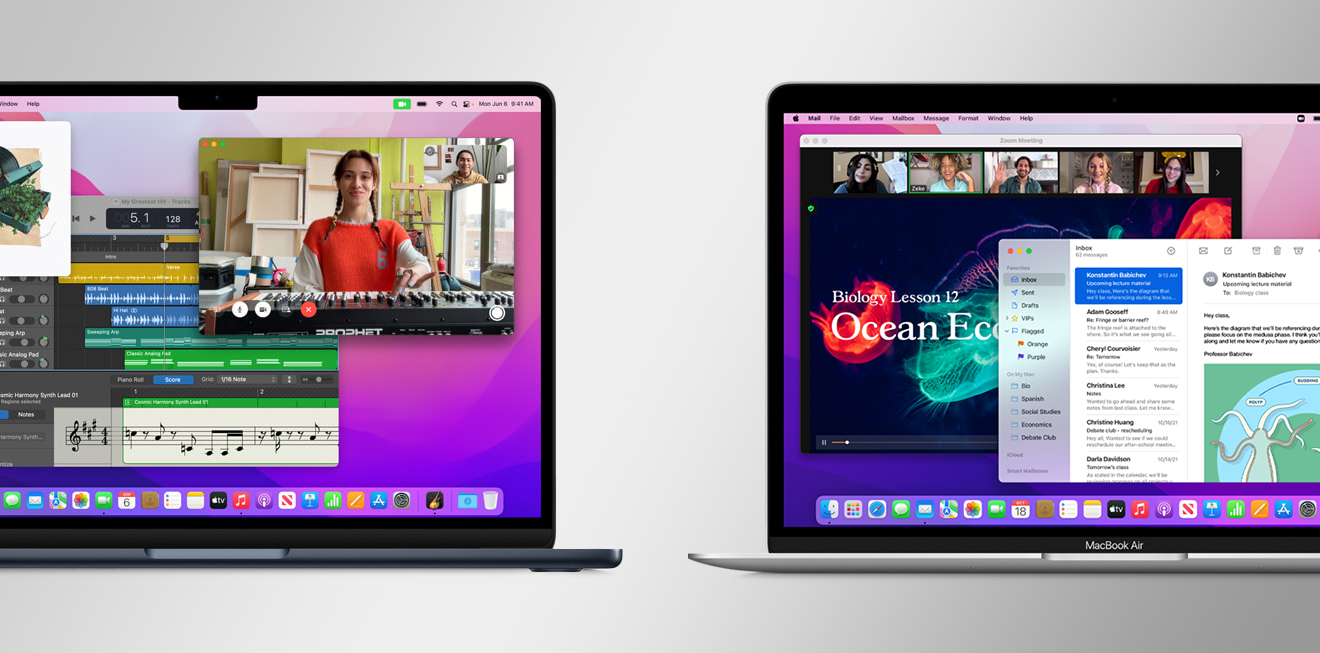
You will get longer battery life (in lighter loads, specifically), so that’s definitely a plus, but — to really harness the full potential of the M2 — you’ll have to invest in a beefier SKU with 512GB of storage, to circumvent the aforementioned SSD issue.
Overall, though, it’s more of an interactive, “stopgap” chip than anything else and is, in fact, built on the same manufacturing process — hence the relatively negligible (but still highly welcome) performance uplift.
Now, make no mistake: the M2 is more powerful. It is faster, and it will perform better in certain tasks and workloads, but the regular M1 certainly isn’t lacking power, and, frankly, most users won’t notice any kind of difference during their day-to-day usage.
To learn more about this topic, make sure to watch the following video:
Which Apple MacBook Should You Go For?
That depends entirely on your needs and budget. Most people will be more than satisfied with the M1 and M2 MacBook Airs.
They punch way above their weight class and can easily compete with laptops that are both larger and more powerful (specs-wise).
The 14” and 16” MacBook Pros should only be bought by the most demanding users out there — the creative professionals and those with production-heavy workloads.
The 13” MacBook Pro, on the other hand, is in a very weird position as it’s nowhere near as powerful as its 14” and 16” brethren and is yet only marginally more capable than the Air.
It can sustain its performance for longer due to it having active cooling, but the difference — while certainly measurable — isn’t large enough to warrant the investment.
Apple Overdelivered With the M1
The thing is, Apple knocked it out of the park with the M1 and its Pro and Max variants. We’re talking about a superb SoC that essentially left all of its competition in the dust. And, in a way, it was too good for the asking price.
There’s a reason why Apple stopped producing M2 chips a few months ago — its sales targets simply weren’t met.
The M2 is better (often tangibly so), but the performance delta simply doesn’t warrant the investment, hence the lower-than-expected sales numbers.
If one can get, say, 90% of M2’s performance for noticeably less money, why would one even entertain the idea of going with the more novel chipset?
This sentiment is echoed by both tech journalists and buyers alike, so it should really come as no surprise that the M2 “failed to deliver.”
Are Apple MacBooks Good for Gaming?
That’s a very tough question to answer. They are not, in general, but it really depends on the games you’re most interested in playing.
If you’re into emulation, you’ll be happy to know that the vast majority of today’s most popular emulators have actually been ported and can now run natively without the use of Rosetta 2.
You can also get a surprisingly solid gaming experience if you’re willing to mess around with CrossOver and Parallels. Using these third-party tools and workarounds does work, but setting them up will require ample grunt work — it’s not a plug-and-play kind of solution.
Ditto for the recently unveiled Game Porting Toolkit:
There’s also a solid number of natively supported macOS games on Steam and Epic Games Store, so it’s definitely not as bad as it was just a couple of years ago. Your mileage, as always, will vary.
If you’re interested in this topic, we suggest you give Andrew Tsai’s YouTube channel a look; he’s been benchmarking and testing all the latest builds and optimizations for a while now and is the “go-to” source for gaming on ARM-based MacBooks.
Apple MacBooks — Amazing, But With an Asterisk
These MacBooks, while certainly spectacular, aren’t for every kind of user and use-case.
If you’re into 3D modeling or, say, CAD, you’ll still want to go with a Windows-based laptop.
Ditto for any kind of gaming.
A good number of “pro-grade” software— like AutoCAD, for instance — has been ported to Apple Silicon, but that may not be the case for your software suite of choice.
If what you need is natively supported, then you’ll love these machines and the power and efficiency which they bring to the table. There’s really nothing like it.
Apple MacBook Laptops — What to Expect in 2023 and Beyond
We’re essentially waiting for the M3 to drop and, subsequently, be incorporated into Apple’s entire product stack.
This will either happen near the end of this year or, conversely, during the Spring of 2024. The 13” MacBook Air and Pro will be the first to be updated, with the 14” and 16” MacBook Pros following suit.
Apple is also rumored to be working on a passively cooled 12” MacBook but it’s still unclear whether that’s anywhere near close to release. We’ll just have to wait and see.
The M3 is worth waiting for, though, as it’ll provide a tremendous boost in both performance and efficiency, thanks to its more advanced manufacturing process (3nm as opposed to 5nm).
Conclusion — Are Apple MacBooks Worth It?
Without a shadow of a doubt. They’re among the best laptops on the market right now and by the looks of it, that isn’t going to change anytime soon.
Apple has too great a lead over its competition, hence the spectacular sales numbers and overwhelming hype.
AMD is the only real “threat” in that sense, as its latest processors are much more efficient than they were in the past.
The best x86 laptops out there still can’t compete on even footing, though, and there’s a very good reason why that’s the case: each separate component is designed and built by a different company, which is then placed within an entirely different chassis (with different thermal modules) from disparate OEMs.
There are simply too many variables that go into play.
Apple, on the other hand, has total control over both its hardware and its software.
Its ARM chipsets are a breakthrough, but so is how they coalesced with the rest of Apple’s efforts.
This Cuppertino-based giant really went the extra mile to ensure that this transition went as smoothly as possible and, needless to say, the results speak for themselves.
And so, to answer the opening question: are Apple laptops worth the asking price? Without a shadow of a doubt.
FAQ
Let’s go over a few potential questions you might have regarding Apple and its laptop portfolio:
Are Apple MacBooks Any Good?
They’re not just good but, rather, spectacular.
They’re some of the finest and most well-rounded laptops money can buy — and are, therefore, more than worth the investment.
Apple’s warranties and RMA procedures are also top-notch, so if anything happens to go awry, you’ll be able to sort it out in no time.
Just be mindful of their (potential) compatibility issues and, seeing how they offer no upgradeability whatsoever, make sure to buy the right SKU in accordance with your needs — 16GB of RAM is basically a must if you’re a multitasker and have the tendency to run multiple programs at once.
Is Apple a Reputable Laptop Brand?
It is, in many ways, one of the most reputable brands out there and, as such, is held in as high a regard as possible.
Its products sure do sell for a premium, but they don’t come with as many QC issues and, in general, tend to last (a fair bit) longer than equivalent laptops from competing OEMs.
MacBook Air or Pro 13” — What’s the Difference?
The 13” MacBook Pro comes with a brighter display (500 vs. 400 nits), active cooling, slightly better speakers, the oft-criticized Touch Bar in lieu of a dedicated function row, and slightly better battery life.
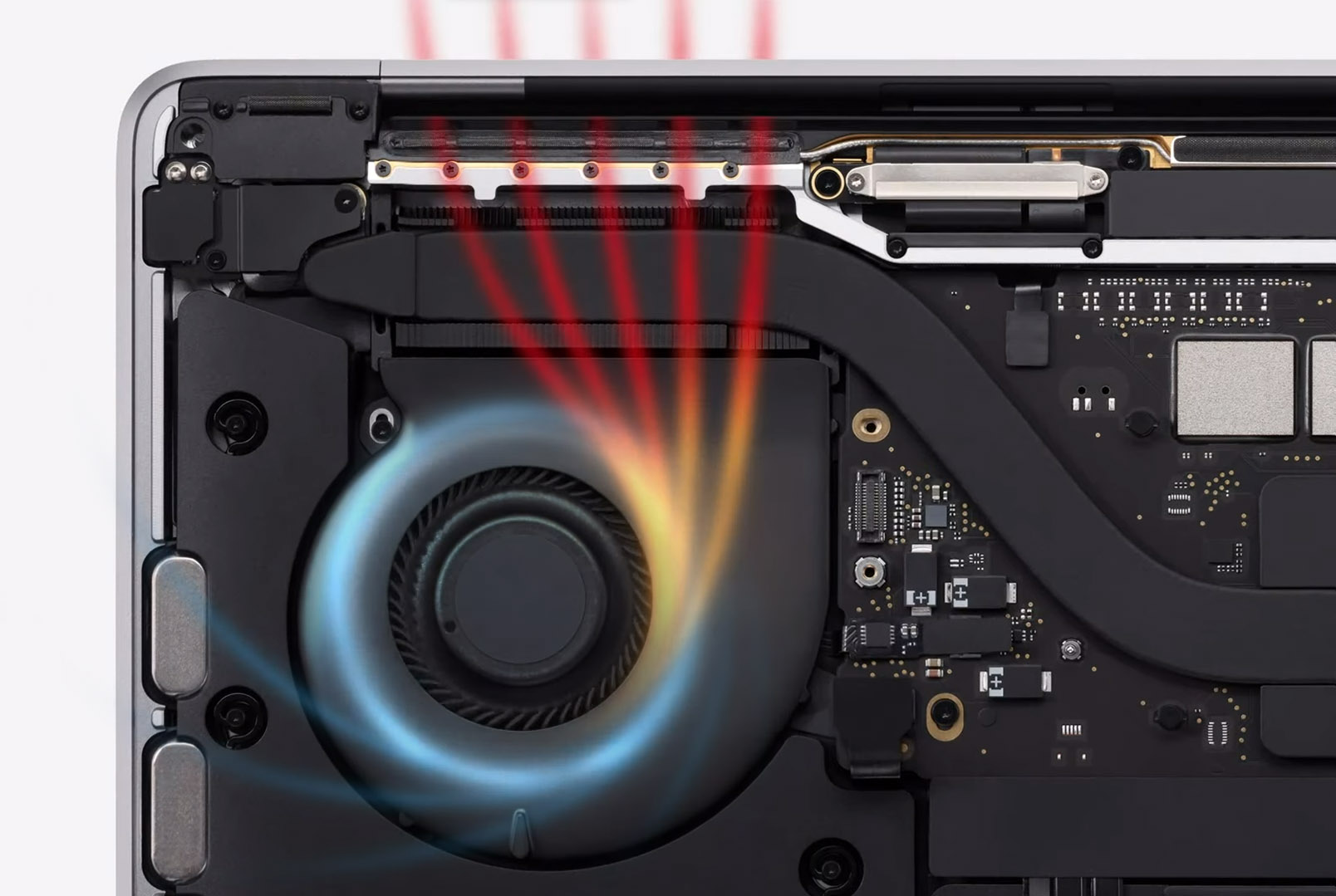
Image Credit: Apple
These are no small benefits and upgrades (other than the Touch Bar which, in essence, is a step backward), but they don’t really justify the higher asking price.
Is the MacBook Pro 14”/16” Worth It?
Absolutely. These laptops are amongst the finest on the market and are stupendously powerful and yet wholly efficient. It’s a mind-blowing combination no other OEM has to offer.
They are, therefore, the absolute best possible choice for software developers, creative professionals, music producers, videographers, and most (but not all) other professions that fall in between.
Which Apple MacBook Should I Buy?
That depends on your needs and budget. The M1 MacBook Air is unrivaled from a price-to-performance standpoint and, frankly, that isn’t going to change anytime soon.
There’s not a laptop out there that can “trade blows” with Apple’s most popular offering as the MacBook Air ticks all the right boxes and, to boot, offers a tremendous level of performance whilst being passively cooled.
The 13” MacBook Pro should generally be avoided as once spec’d out, is actually within spitting distance of the 14” variant — which, obviously, is a much better (if pricier) investment.
The “regular” 13” Pro doesn’t offer a big enough boost in performance when compared to the MacBook Air and is, therefore, in a really weird position.
In other words: it’s nowhere near as “Pro” as Apple wants you to believe.
The 14” and 16” MacBook Pros, on the other hand, stand in a league of their own.
They are, one could argue, perfect laptops with very few (if any) flaws worth mentioning. They excel at a broad range of workloads and are noticeably more capable than anything else which Apple has to offer.
They are on the pricier side (an understatement), but are nonetheless worth the investment.
Over to You
What are your thoughts on Apple’s ARM-based MacBooks? Are they capable enough to meet your needs or are their software-related quirks still a hurdle?
Let us know in the comment section down below and, in case you need any help, head over to our forum and ask away!
![Are Apple Laptops Worth It? [2024 Update] Are Apple Laptops Worth It? [2024 Update]](https://www.cgdirector.com/wp-content/uploads/media/2023/07/Are-Apple-Laptops-Worth-It-Twitter-1200x675.jpg)
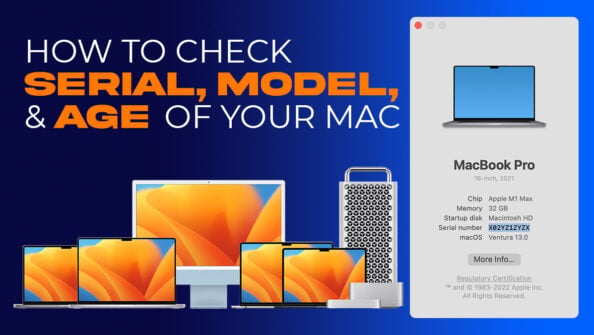
![Which Mac Is the Right Desktop Computer for You? [Update] Which Mac Is the Right Desktop Computer for You? [Update]](https://www.cgdirector.com/wp-content/uploads/media/2023/11/Which-Mac-Is-the-Right-Desktop-Computer-for-You-Twitter-594x335.jpg)
![Are M3 MacBooks Worth It / Worth the Wait? [2024 Update] Are M3 MacBooks Worth It / Worth the Wait? [2024 Update]](https://www.cgdirector.com/wp-content/uploads/media/2023/05/Should-You-Wait-for-the-M3-MacBooks-or-Buy-an-Older-Model-Twitter-594x335.jpg)
![Are MacBooks Good for Video Editing? [2024 Update] Are MacBooks Good for Video Editing? [2024 Update]](https://www.cgdirector.com/wp-content/uploads/media/2023/11/Are-M1-and-M2-MacBooks-Good-for-Video-Editing-Twitter-594x335.jpg)

2 Comments
21 September, 2023
As a tech enthusiast, I got (several) M1 MBAs, because when it launched, it did checked all we been asking for in a laptop: fanless, powerful with an incredible battery life at the same time.
Then the magic vanished here, not because of the hardware itself, even though I still would complain about the lack of ports, the PWM screen giving me headaches, and obviously the non upgradable ram/ssd you got to pay at apple tax. Not a big fan of the CMD key location as well, I much prefer CTRL right a the bottom left edge. You won’t have much choice on aftermarket KB .
To me, the problem is macOS, I really tried to enjoy it but I simply don’t. First, this is strictly personal, these colored childish icons/dock, and general theme make me feel retarded or wanna puke.
The handling and management of windows, like what kind of disturbed mind designed that..wtf..The apps (or lackoff), with some of these that come preinstalled can’t be removed without going through terminal, even then they’ll come back at the next update. Which are online tailored regarding the laptop id (be aware if your company grant you with one, even if it comes BNIB). You can’t install no other OS (please don’t come with Asahi) .
The general feeling it left me with was, taht even though you purchased it, the computer is not really yours, you got to use it the way apple decided.
I need a computer to be some kind of toolbox, a brain associate that compute the way we ask him to.
A PC can run anything, from professional software, to the more obscure hobbyist program. You can read/write onto RFID cards, cars ECU maps, pair it with any cheap raspberry like, or a top of the edge lidar robotic vision module..then play a game with the latest graphics, or one from a 30y old arcade machine. Possibilities are endless.
This is what computers should be, real toolboxes not ruled by some corporations who decide what you’re allowed to do or not.
Or just is it the kid growing up with computers and internet in the 90s speaking, we were hopeful for that future back then.
So, the MBA could have been that perfect on the go toolbox, but as it is with forced macos it’s a turnoff for me, it simply ruined it all. They should have let the hardware fully opened. I’d def. go for a next gen mobile APU from AMD with a dualboot linux distro/custom windows on my next purchase.
22 September, 2023
Hi altavista! Yeah, macOS isn’t for everyone. If you’re okay with its limitations, it’s an incredible operating system, and it really does work as advertized. If not, it’s basically the worst thing in the world. I guess that’s why it’s so important to be aware of one’s needs and preferences. I’m personally glad that it exists, and it’s actually a lot more capable than people realize. It’s obviously nowhere near as flexible as Windows, but for most folks and those who want a great out-of-the-box experience, it’s incredibly consistent and stable.
By the way, you can easily re-map all macOS-related modifier keys via the settings (and it remembers your choice on a per-peripheral basis).